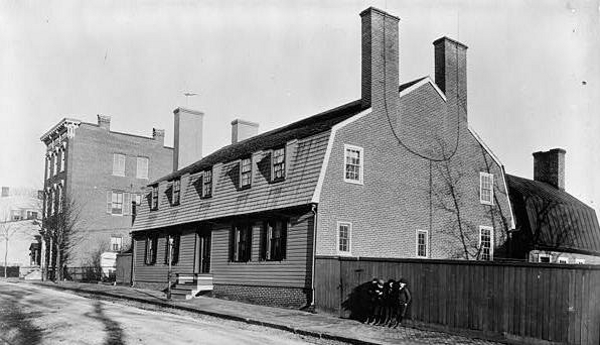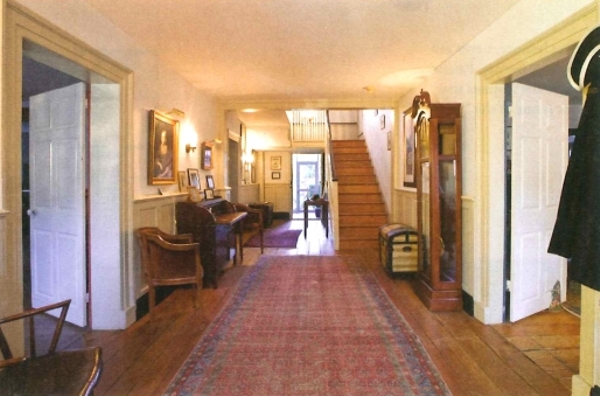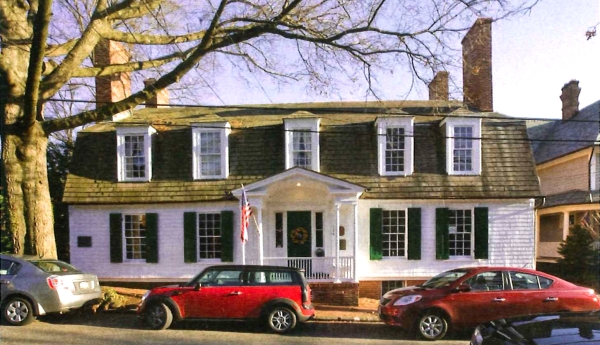The Anne Catherine And Jonas Green House in Annapolis: The "Greenest" House in AmericaThe
house at 124 Charles Street in Annapolis, formerly known as the “Jonas
Green House” is now the “Anne Catherine Green House”. The name
change has been made by the current occupants of the house Dede Brown and
Randall Brown, the fifth great grandson of Jonas and Anne. Jonas and Anne
were married in the 1730’s while he was a printer’s apprentice to
Benjamin Franklin in Philadelphia. They relocated to Annapolis in 1738,
set up a print shop in the yard behind their home and published the Maryland
Gazette newspaper. Jonas died in 1767 with marginal assets, but within
several years, Anne expanded the printing business to include official
governmental publications, and then the printing of paper money backed by
the State of Maryland. Anne Catherine Green was the first woman to publish
and own an American newspaper.
When Anne and Jonas came to Annapolis the house was probably only three rooms. There was a detached kitchen building a few steps away. As the family grew the house grew, Anne bore fourteen children, six surviving to adulthood. By the 1770’s it had the form we see today: a central hall flanked on two sides by four rooms. “Center Hall Colonial” is a term frequently misattributed to boring suburban houses, but the Anne Catherine Green house is an authentic center hall colonial.
The
house is extraordinary for many reasons, but three stand out: the original
eighteenth century floor plan is unaltered; the architectural design
achieves enduring balance; and it has been occupied exclusively since the
1740’s by the Green family. What allows this house to survive with the
initial construction intact? How is it that this floor plan has never
received a major alteration? Sure there have been slight changes: the
installation of electricity, heating systems, and bathrooms, but the
fitting in of these conveniences have not altered the original design of
this home. It is the enduring quality of the architectural design with the
superior efficiency of the floor plan that has blessed this house with
longevity and made it a home loved and revered. People want
to live in this home because the architectural design is so pleasant.
The
original floor plan includes the central hall which is
Today
we strive to design and build “green” homes: buildings that are
environmentally sustainable. These buildings offer low energy consumption
for their construction, and their use. “Green” homes today are
evaluated by their energy consumption as a ratio to their useful life. The
US Green Building Council has ratings for this ratio, a building maybe
designated with Platinum, Gold or Silver ratings. The Anne Catherine Green
House greatly surpasses the highest mark of the rating system. The home
was built completely with locally sourced sustainable materials and labor.
There is not one intensely consumptive carbon product and not one
carcinogenic product used in the original construction. Any “green
building” evaluation is obliterated by the fact that the house has
served for 275 years. Eleven generations of families could have been
served by the single original superior construction effort. It is a model
for us to build by today. While thinking of building a new home today, I recommend two things be kept in mind: build the right size home, and build it to last for the next 300 years. The Anne Catherine Green House has about 3000 square feet in the two story center hall part, and another 1000 square feet in kitchen wing. Over the years this size has the balance of not being too big a burden to maintain, and not too small to accommodate the dynamic needs of the family. The interior woodwork also achieves perfect balance, never too monumental to be overpowering, and never too plain to be boring. Balance, flexibility, and enduring architectural design are some of the features that have sustained this building’s unaltered longevity. This is one of the “greenest” house in America.
|
|







